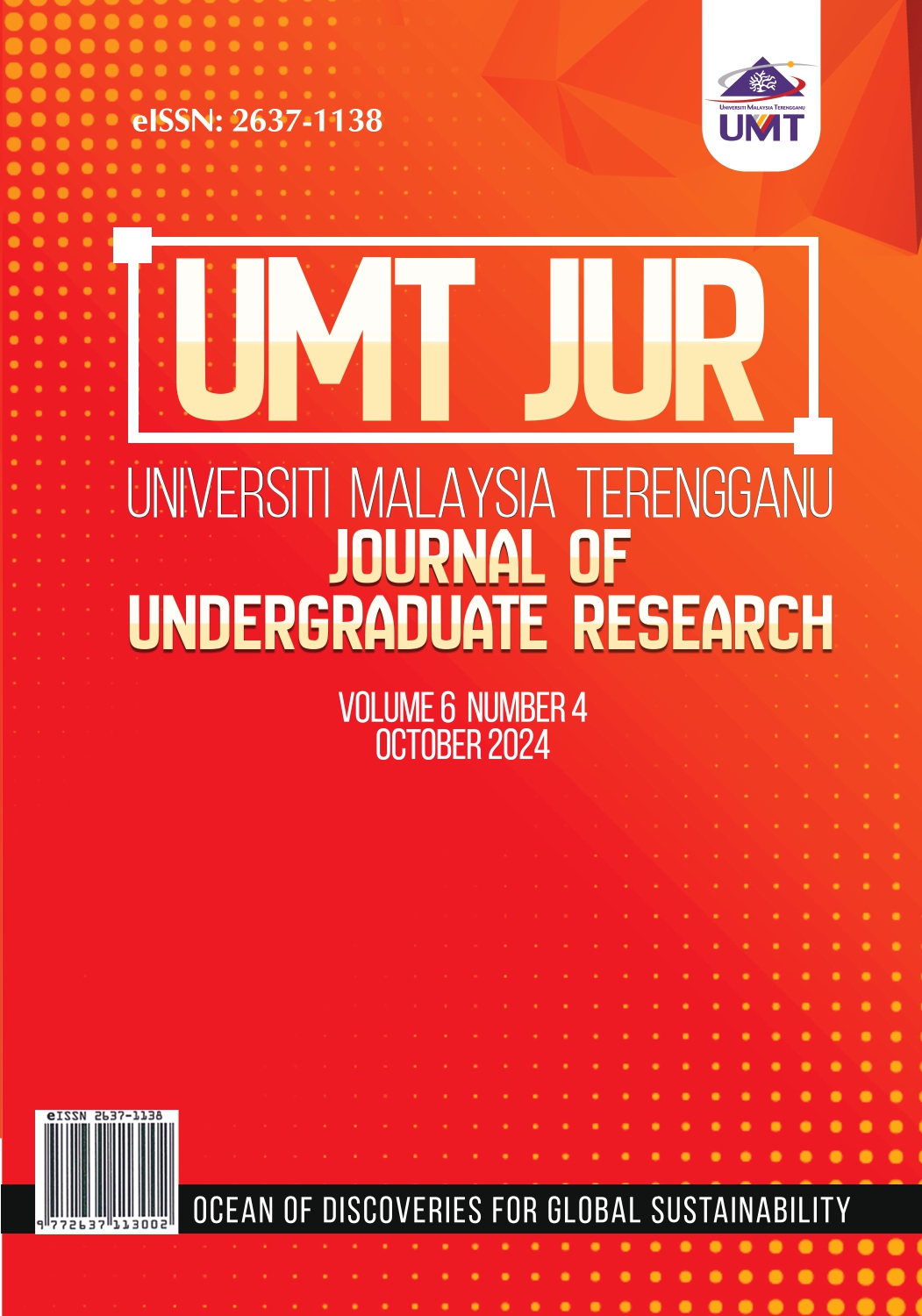Diversity and Species Composition of Non-Volant Small Mammals in Chemerong Recreational Forest and Kenyir, Terengganu
DOI:
https://doi.org/10.46754/umtjur.v6i4.543Keywords:
Diversity, non-volant small mammals, recreational forest, species composition, TerengganuAbstract
Malaysia comprises a large number of mammal species, most of which are small mammals. However, the diversity and species composition of non-volant small mammals remains understudied, especially on the east coast of Peninsular Malaysia. This study aims to determine the diversity and species composition of non-volant small mammals in the Chemerong Recreational Forest and Kenyir. Ten sampling sessions, with a total of 3,000 sampling efforts, were conducted between November 2021 and October 2022 using 100 collapsible wire-mesh live traps. In Chemerong Recreational Forest, 50 individuals were identified from 11 species, which is dominated by Rattus rattus (n = 14), followed by Maxomys whiteheadi and Tupaia glis with nine individuals, respectively. In Kenyir, 62 individuals were captured from nine species, primarily comprising Sundamys muelleri (n = 15), Maxomys rajah (n = 14), and Rattus rattus (n = 13). Results reveal that the diversity and species composition varied between the two study areas. Chemerong Recreational Forest demonstrates a higher diversity of non-volant small mammals, while Kenyir exhibits higher species dominance. This study provides baseline data for further study and conservation efforts for non-volant small mammal species in the region.
References
Acharya, P. R. (2001). Small mammals: Viable conservation issues. Life Science Journal Magazine, 2(1), 15-20.
Azmir, K., Aman, M., Rahmat, M., Yahya, N., Samsuddin, N., Tarmizi, N., & Abdullah, M. T. (2022). Assessment of Tanjung Bewah karst at Tasik Kenyir and construction of a framework for high value biodiversity area. Malayan Nature Journal, 73, 459-468.
Benacer, D., Woh, P. Y., Zain, S. N. M., Amran, F., & Thong, K. L. (2013). Pathogenic and saprophytic Leptospira species in water and soils from selected urban sites in Peninsular Malaysia. Microbes and Environments, 28(1), 135-140. https://doi.org/10.1264/ jsme2.me12154 DOI: https://doi.org/10.1264/jsme2.ME12154
Baqi, A., Azhar, I., Chen, E. W., Khan, F. A. A., Lian, C. J., Nelson, B. R., & Kumaran, J. V. (2021). The diversity of small mammals in Pulau Perhentian Kecil, Terengganu, Malaysia. Journal of Threatened Taxa, 13(6), 18427-18440. http://dx.doi.org/10.11609/jott.6148.13.6.18427-18440 DOI: https://doi.org/10.11609/jott.6148.13.6.18427-18440
Bourliere, F. (1975). Mammals, small and large: The ecological implications of size. Small mammals: Their productivity and population dynamics (pp. 1-9). Cambridge University Press, London.
Bernard, H., Fjeldsa, J., & Maryati, M. (2009). A case study on the effects of disturbance and conversion of tropical lowland rain forest on the non-volant small mammals in North Borneo: Management implications. Mammal Study, 34(2), 85-96. https://doi.org/10.3106/041.034.0204 DOI: https://doi.org/10.3106/041.034.0204
Chaisiri, K., Chaeychomsri, W., Siruntawineti, J., Bordes, F., Herbreteau V., & Morand, S. (2010). Human-dominated habitats and helminth parasitism in Southeast Asian murids. Parasitology Research, 107, 931- 937. https://doi.org/10.1007/s00436-010- 1955-2 DOI: https://doi.org/10.1007/s00436-010-1955-2
Chao, A., Colwell, R. K., Lin, C. W., & Gotelli, N. J. (2009). Sufficient sampling for asymptotic minimum species richness estimators. Ecology, 90(4), 1125-1133. https://doi.org/10.1890/07-2147.1 DOI: https://doi.org/10.1890/07-2147.1
Chao, A., Gotelli, N. J., Hsieh, T. C., Sander, E. L., Ma, K. H., Colwell, R. K., & Ellison, A. M. (2014). Rarefaction and extrapolation with Hill numbers: A framework for sampling and estimation in species diversity studies. Ecological Monographs, 84(1), 45- 67. https://doi.org/10.1890/13-0133.1 DOI: https://doi.org/10.1890/13-0133.1
Corbalán, V., & Debandi, G. (2006). Microhabitat use by Eligmodontia typus (Rodentia: Muridae) in the Monte Desert (Argentina). Mammalian Biology, 71(2), 124-127. https://doi.org/10.1016/j. mambio.2005.11.009 DOI: https://doi.org/10.1016/j.mambio.2005.11.009
Corlett, R. T. (2017). Frugivory and seed dispersal by vertebrates in tropical and subtropical Asia: An update. Global Ecology and Conservation, 11, 1-22. https://doi. org/10.1016/j.gecco.2017.04.007 DOI: https://doi.org/10.1016/j.gecco.2017.04.007
Department of Wildlife and National Parks. (2023). Red list of mammals for Peninsular Malaysia. Department of Wildlife and National Parks (Perhilitan) Peninsular Malaysia.
Francis, C. (2019). Field guide to the mammals of South-east Asia (2nd ed.). Bloomsbury Publishing.
Gould, E. (1978). The behavior of the moonrat, Echinosorex gymnurus (Erinaceidae) and the pentail shrew, Ptilocercus lowi (Tupaiidae) with comments on the behavior of other Insectivora. Zeitschrift für Tierpsychologie, 48(1), 1-27. https://doi. org/10.1111/j.1439-0310.1978.tb00245.x DOI: https://doi.org/10.1111/j.1439-0310.1978.tb00245.x
Hammer , Ø., Harper, D. A. T., & Ryan, P. D. (2001). PAST: Paleontological statistics software package for education and data analysis. Palaeontologia Electronica, 4(1), 1-9. http://palaeo-electronica.org/2001_1/past/ issue1_01.htm
IUCN (2018). Species survival commission small mammal specialist group. IUCN Red List of Threatened Species. http://www.small mammals.org/
Kvartalnov, P. V. (2022). Ecology and behavior of the slender-tailed tree shrew (Dendrogale murina, Scandentia). Biology Bulletin, 49(7), 915-923. https://doi.org/10.1134/ S1062359022070093 DOI: https://doi.org/10.1134/S1062359022070093
Laurent, A., Bertin K. A., Hilaire K. B., Blaise, K., & Inza, K. (2020). Species composition and community structure of terrestrial small mammals in Tanoé-ehy Swamp Forest (South-East Ivory Coast): Implication for conservation. Nature Conservation Research, 5(1), 53-63. DOI: https://doi.org/10.24189/ncr.2020.005
Nadchatram, M. (2008). The beneficial rain forest ecosystem with environmental effects on zoonoses involving ticks and mites (ACARI), a Malaysian perspective and review. Tropical Biomedicine, 25(2), 1-92. https://www. sciepub.com/reference/11185
Nor Zalipah, M., Roslan, A., Senawi, J., Jayaraj, V. K., Azhar, M. I., Abdullah, M. T., & Lim, B. L. (2019). Checklist of small mammals of Hulu Terengganu, Terengganu. In Greater Kenyir Landscapes: Social Development and Environmental Sustainability: From Ridge to Reef, 191-200. DOI: https://doi.org/10.1007/978-3-319-92264-5_18
Osman, A., Mariwah, S., Yawson, D. O., & Atampugre, G. (2022). Changing land cover and small mammal habitats: Implications for landscape ecological integrity. Environmental Challenges, 7, 100514. DOI: https://doi.org/10.1016/j.envc.2022.100514
Pimsai, U., Pearch, M. J., Satasook, C., Bumrungsri, S., & Bates, P. J. (2014). Murine rodents (Rodentia: Murinae) of the Myanmar-Thai-Malaysian Peninsular and Singapore: Taxonomy, distribution, ecology, conservation status, and illustrated identification keys. Bonn Zoological Bulletin, 63(1), 15-114.
Rahim, N. A. A., Ahmad, N. I. I., Zakaria, A. A., Pesiu, E., Salam, M. R., Mamat, M. A., & Abdullah, M. T. (2016). Brief survey of non-volant small mammals on Pulau Perhentian Besar, Terengganu, Malaysia. The International Seminar on the Straits of Malacca and the South China Sea 2016.
Rhim, S. J., Lee, J. Y., Kim, M. J., Park, S. J., Lee, E. J., & Lee, W. S. (2007). Differences in small rodent populations between forest and forest road areas. Journal of Korean Society of Forest Science, 96(3), 245-250.
Saufi, S., Ravindran, S., Hamid, N. H., Zainal Abidin, C. M. R., Ahmad, H., Ahmad, A. H., & Salim, H. (2020). Diet composition of introduced Barn Owls (Tyto alba javanica) in urban area in comparison with agriculture settings. Journal of Urban Ecology, 6(1), Article juz025. https://doi.org/10.1093/jue/ juz025 DOI: https://doi.org/10.1093/jue/juz025
Shafie, N. J., Halim, N. S. A., Zalipah, M. N., Amin, N. A. Z. M., Esa, S. M. A. S., Md- Nor, S., Casanovas-Massana, A., Ko, A. I., Palma, F., Souza, F. N., & Costa, F. (2021). Knowledge, attitude, and practices regarding leptospirosis among visitors to a recreational forest in Malaysia. The American Journal of Tropical Medicine and Hygiene, 104(4), Article 1290. DOI: https://doi.org/10.4269/ajtmh.20-0306
Terengganu Forestry. (2016, January 2). Maklumat perhutanan: Hutan simpan kekal. http://trgforestry.terengganu.gov.my/index.php?option=com_content&view=article&id=79&Itemid+321&lang=my.
Von Rintelen, K., Arida, E., & Häuser, C. (2017). A review of biodiversity-related issues and challenges in megadiverse Indonesia and other Southeast Asian countries. Research Ideas and Outcomes, 3, Article e20860. DOI: https://doi.org/10.3897/rio.3.e20860
Wahab, N. A., Kamarudin, M. K. A., Anuar, A., Ata, F. M., Sulaiman, N. H., Baharim, N. B., & Muhammad, N. A. (2017). Assessments of lake profiling on temperature, Total Suspended Solid (TSS) and turbidity in the Kenyir Lake, Terengganu, Malaysia. Journal of Fundamental and Applied Sciences, 9(2S), 256-278. DOI: https://doi.org/10.4314/jfas.v9i2s.18
Wells, K., & Bagchi, R. (2005). Eat in or take away – seed predation and removal by rats (Muridae) during a fruiting event in a dipterocarp rainforest. The Raffles Bulletin of Zoology, 53(2), 281-286.
Wells, K., Pfeiffer, M., Lakim, M. B., & Kalko, E. K. (2006). Movement trajectories and habitat partitioning of small mammals in logged and unlogged rain forests on Borneo. Journal of Animal Ecology, 75(5), 1212-1223. DOI: https://doi.org/10.1111/j.1365-2656.2006.01144.x
William-Dee, J., Khan, F. A. A., Rosli, Q., Morni, M. A., Azhar, I., Lim, L. S., Tingga, R. C. T., & Rahman, M. R. A. (2019). Comparative distribution of small mammals diversity in protected and non-protected area of Peninsular Malaysia. Tropical Life Sciences Research, 30(2), 131-147. DOI: https://doi.org/10.21315/tlsr2019.30.2.10
Wolton, R. J. (1985). The ranging and nesting behaviour of wood mice, Apodemus sylvaticus (Rodentia: Muridae), as revealed by radio‐tracking. Journal of Zoology, 206(2), 203-222. DOI: https://doi.org/10.1111/j.1469-7998.1985.tb05645.x
Zwolak, R., Pearson, D. E., Ortega, Y. K., & Crone, E. E. (2010). Fire and mice: Seed predation moderates fire’s influence on conifer recruitment. Ecology, 91(4), 1124- 1131. DOI: https://doi.org/10.1890/09-0332.1
Additional Files
Published
How to Cite
Issue
Section
License
Copyright (c) 2024 Universiti Malaysia Terengganu Journal of Undergraduate Research

This work is licensed under a Creative Commons Attribution-ShareAlike 4.0 International License.




